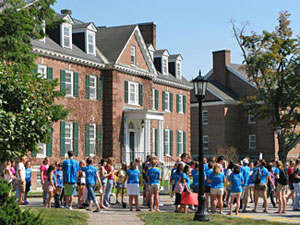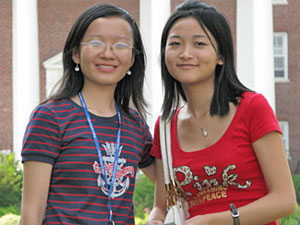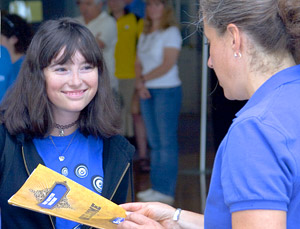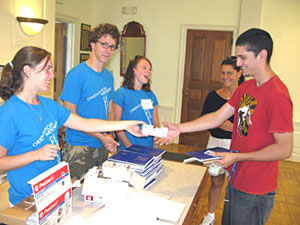
A Time of Transition for First-Year Students
This year's New Student Orientation program welcomed the largest and most diverse class in Colby-Sawyer's history to campus for three days of events and activities before classes began. The program's goal is to “orient students to campus life and prepare them to be successful both academically and socially,” according to Campus Activities Director Sharon Williamson, who coordinated the program with assistance from faculty, staff and 42 students who served as Orientation Leaders.
It's a tall order to ease the transition to college for 400 first-year students, who have all arrived with different backgrounds, expectations and levels of readiness for college, and are at once excited and anxious. Student Orientation is largely about connecting new students to each other and to their new environment so that they can begin to feel like part of the community.
For Daphney Noel, a self-described “outgoing person” from Cambridge, Mass., the transition to college may have been easier than for some of her peers. As a prospective student, she had visited campus several times and stayed for an over-night in a residence hall, and she had deliberately chosen to attend a small school where she “could focus, and where the teachers would know my name.”
During these visits she was surprised that almost everyone on campus was friendly and said hello to her. “I knew I wouldn't be left behind if I came here,” she said. “They made me feel good, like they wanted me to be here at Colby-Sawyer.”

Noel was also fortunate in that she is part of the Progressive Scholars program and had arrived on campus this fall with a cohort of other new students from her high school, Cambridge-Rindge & Latin School. When the whirlwind of “get-to-know-you” games at Orientation began, she felt secure enough to separate from her former classmates and join in.
“I thought Orientation would be—'here are your keys, here's your room'—but instead we played all these games and had a chance to act silly and show off a different side of our personality,” she explains. “It was very effective in helping me connect with other people and find common interests. If we didn't have all these activities, we wouldn't be talking so much now.”
While Tom Doerr of Winchester, Mass., says he was “a little nervous” before his arrival, he admits it was “wicked exciting” at the same time. “I was just really looking forward to having a new experience like this. Once I got here, the nervousness went away, and I felt like I fit right in,” he says.
For Doerr, the orientation leaders were extremely helpful in introducing him to college life in general, and in particular, to the computer network and programs such as Blackboard, a course management tool that he would soon encounter in his classes. “I was able to meet a lot of great people and learn a lot about the college,” he said. “Orientation made me see how important it is to attend all the programs going on in the first few weeks, because that's when you meet people and make new friends.”

“The Overall Energy Was Incredible”
The 2008 New Student Orientation, from Friday, Sept. 7, through Sunday, Sept. 9, was a mix of social gatherings and get-acquainted activities, entertainment by comedians and musicians, and educational activities that introduced new students to the college's resources and routines.
Sharon Williamson assisted with last year's orientation program, but in 2008, in her new role as the program's coordinator, she began months in advance to design an even more comprehensive program that would meet first-year students' social and academic transition needs. She received input from a faculty committee through Academic Dean Beth Crockford, and from professional staff in Academic Affairs and Student Development, and she enlisted and trained the many upper-class students who would serve as orientation leaders.
“This year was much better in many ways—the enthusiasm of the orientation leaders, the participation by the first-year students, and the overall energy all weekend was incredible,” says Williamson.
Williamson enjoys, and has much experience with, putting on large events, and she believes the challenge of Orientation is to recognize the developmental stages of new students while planning an appropriate welcome into an academic community. “Being in transition can inhibit learning,” she points out.
For this reason, some orientation activities were linked to the curriculum and spilled over into the semester, such as the required summer reading of the book, Three Cups of Tea, which was selected by faculty. Discussions of the book will take place in three campus events and continue in the students' Pathway Seminars and Writing 105 classes. “Students begin the orientation process those first few days, but it takes time for them to really become part of our community,” Williamson says.
This year's class, with its larger size and greater diversity, presented new opportunities for the program's planners. “We approached the diversity of this year's class thinking the same, yet differently...All students would receive the same orientation to campus, yet it would be different for each of them,” she explains.
“We were prepared to work with students as individuals to meet their needs. The students were divided into their Pathway classes and all were mixed together. It was a great way for the Progressive Scholars and international students to meet and get to know the rest of the class in small groups,” she adds.

“Am I Ready for College?”
Other first-year students enjoyed even more of a jumpstart in their transition to college life: those who participated in the New Student Trip and the pre-orientation program for international students. Over the summer, following his high school graduation, Chris Casey of Amherst, Mass., began worrying about his impending move to college.
“It hit me really hard because I wasn't sure of what to expect. I was always questioning myself, wondering, 'Am I ready for college, what is it going to be like, am I going to like it, am I going to fit in?'” He decided to join some 36 other incoming students on the week-long New Student Trip. Although he arrived feeling uncomfortable and nervous, Casey connected with his classmates during a week of rigorous outdoor activities that included cycling, canoeing and hiking in the White Mountains.
“We did everything together...we were able to build relationships prior to coming to college, and this was very important because I would have been overwhelmed if I had to come to school not knowing anyone,” Casey explains. “I would not have been in such a good and mentally healthy state right now if I hadn't made those connections before coming to school.”
Similarly, first-year international students arrived well in advance of the larger orientation program to get to know the campus and staff and faculty members, as well as their host families in the community. This smaller orientation program, led by International Student Advisor Cindy Benson and ESL Coordinator David Elliott, also educates international students about the country's and the campus's rules and regulations, and links students to campus services such as the Baird Health and Counseling Center, Campus Safety, the Student Learning Collaborative and the library and Information Resources.
“When international students arrive, they're not all ready to be on their own yet,” says Benson. “We need to assess their English language ability and connect them to people on campus who will serve as resources for them. They also need to purchase a lot of supplies that they're not able to bring from their home countries. Basically, the International Student Orientation brings them up to speed so they're on equal footing with the other students.”
Zhu “Julia” Ze, one of several new students from China, says the early orientation program gave her a broad overview of what college would be like. “Cindy and David did a lot to help us adapt to a new environment and gave us a sense of belonging,” she says.
Another student, Achic “Sisa” Castro from Ecuador, says that while it was initially a bit difficult to communicate with other international students, the group soon began to speak English more comfortably and understand each other. “We found a little family, all with the same experiences, and we became very close to each other,” she says.
When it came time to join the larger New Student Orientation, she felt secure and ready for the experience. “I was used to my little family, and it was like meeting the rest of the family. I got to meet this huge family, a lot of people with some of the same interests. They found it so interesting that we're from different countries; they want to know about our countries and our customs.”

Upper-Class Students Leading the Way
Most of the new students interviewed, as well as those who responded to a survey, cited the orientation leaders, upper-class students, as one of their most influential resources in preparing for college life. The leaders' organized activities and often shared their own personal experiences, and what they'd done to be successful at Colby-Sawyer.
“As an orientation leader, we should be positive, upbeat, encouraging and supportive,” says Amy Hebert '10. “The most important part is being a friendly, positive role model and representative of Colby-Sawyer College.” Hebert feels that the diversity of the new class added a new dimension to the orientation experience. “Having more people of different backgrounds helps everyone see from different perspectives and become more educated about the world. Although there are language barriers, learning to overcome them can only make us stronger.”
For Kate Bishop '09, her most important role as an orientation leader was to stress the importance of getting involved in campus life. She thought the orientation activity called Play Fair was one of the most successful events because it helped push students beyond their comfort zones. “It forced a lot of the first-years to branch out and try new things with new people,” she said.
This year's orientation events received overall high marks from the student surveys, and Williamson was pleased with students' level of enthusiasm and participation in the programs. She's hopeful, as are the first-year students, that they will go on to make deeper connections with others, use the resources available to them, seek support when they need it, and become contributing and happy members of the Colby-Sawyer community. “This is the ultimate goal of New Student Orientation,” she concludes.


